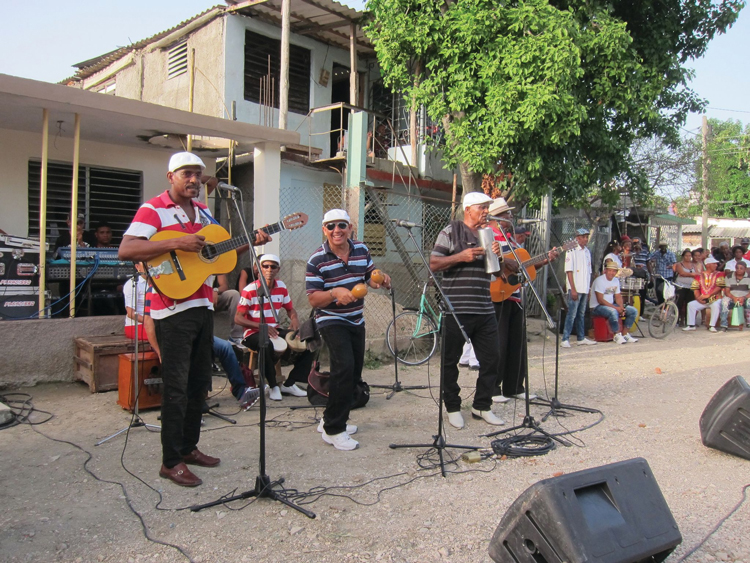(headline image: Grupo Changüí de Guantánamo – Photo by Gianluca Tramontana)
Changüí is an early form of traditional Cuban music from the sugar cane lands, featuring an instrumentation that includes the tres, bongos, güiro, maracas, and the marímbula. Notably, changüí is thought to be the predecessor of son montuno.
Its origins are in the rural communities of the Yateras Mountains in Eastern Cuba, in the Guantánamo Province. For two centuries, this rhythm has been the favorite dance music of farmers in the region that includes what are today the towns of Guantánamo, Baracoa, Yateras, El Salvador and Manuel Tames.
The roots of changüí are the structure and elements of the Spanish canción combined with African rhythms of Bantú-Arará origin. Additionally, the Spanish guitar and its Cuban variations, plus a variety of African percussion instruments, join forces in this deeply grounded genre.
One of the most peculiar instruments used to play changüí is the tres, a Cuban type of guitar that gives the genre its distinctive sound. Indeed, the tres follows the melodic line of the song and reinforces the harmonic structure of the guitar instruments.
Whenever there was a changüí dance held, it was never referred to as a ‘party’. It was always referred to as a ‘changüí’ and gave cause for a great celebration. Women play a central role in changüí, often hosting parties and venues where the music is played.

In 2021, Petaluma Records released a 3 CD boxed set titled Changüí – The Sound of Guantánamo. This is the first comprehensive collection of changüí music, shedding light on an exciting, yet under-documented cultural tradition. The collection includes 50 tracks across three CDs and highlights the unique, communal sound of changüí. Notably, most of the groups featured have never recorded music before, with only a few exceptions, such as Grupo Familia Vera’s “Inspiración de los Pueblos” and Grupo Estrellas Campesinas’ “Changüí en Yateras.”
The recordings were captured by independent producer and music journalist Gianluca Tramontana, whose work has been featured in MOJO Magazine, Rolling Stone, NPR, and the BBC. Having visited Cuba since the 1990s, Tramontana recognized the lack of authentic, on-location recordings of changüí music. Beginning in 2017, he spent two years traveling through Guantánamo, from the mountainous villages of Yateras, where changüí is said to have originated, to Guantánamo City, documenting this historically rich, riff-based, and mostly improvised music. This easternmost province of Cuba, a wellspring of the country’s musical traditions, has influenced legendary artists such as Buena Vista Social Club, Celina González Zamora, and Compay Segundo.
Upon returning to New York, Tramontana collaborated with four-time GRAMMY-winning producer Steve Rosenthal, known for his work on archival projects involving Alan Lomax, Woody Guthrie, and Les Paul. Rosenthal praised the recordings for capturing the raw energy and authenticity of rural celebrations, describing them as a vivid snapshot of the region’s musical culture. “Gianluca’s time spent with the people of Guantánamo allowed the musicians to perform with ease,” Rosenthal noted, emphasizing the collection’s immersive quality.
The final production of the collection was supported by Petaluma Records, mix engineer Ed McEntee, and three-time GRAMMY-winning mastering engineer Michael Graves. The physical packaging, including an extensive booklet, was designed by GRAMMY-winning graphic designer Barb Bersche.
Changüí Artists
Grupo Changüí de Guantánamo, Las Flores del Changüí, Changüí Santiago, Elio Revé, Grupo Estrellas Campesinas, Grupo Familia Vera, El Guajiro y su Changüí, Melquíades y su Changüí, Mikikí and his Brothers, Pedro Vera, Popó y su Changüí, Armando “Yu” Rey Leliebre, Celso Fernández Roja.
Arturo O’Farrill, founder of the Afro Latin Jazz Orchestra said about changüí: “If music be the fabric of life in the rest of Cuba then changüí is existence itself. It’s as if guantanameros were created solely for the purpose of sharing in the music of changüí, to the betterment of the rest of the world.”
(sources: Changüí Santiago, Petaluma Records)
Chan Books
Origins of Cuban Music and Dance: Changüí by Benjamin Lapidus


